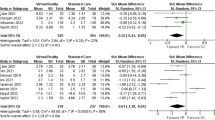Abstract
Virtual reality (VR) as a distraction tool decreases anxiety and fear in children undergoing procedures, but its use has not been studied during transthoracic echocardiograms (TTEs). We hypothesized that VR in children undergoing pre-intervention TTEs decreases anxiety and fear and increases TTE study comprehensiveness and diagnostic accuracy when compared with standard distractors (television, mobile devices). Patients (6–18 years old) scheduled for pre-intervention TTEs at Lucile Packard Children’s Hospital in 2021 and 2022 were prospectively enrolled and randomized to VR and non-VR groups. Patients completed pre- and post-TTE surveys using the Children’s Anxiety Meter-State (CAM-S) and Children’s Fear Scale (CFS). Patients, parents, and sonographers completed post-TTE experience surveys. TTEs were reviewed by pediatric cardiologists for study comprehensiveness and compared with electronic medical records for diagnostic accuracy. Among 67 enrolled patients, 6 declined VR, 31 randomized to the VR group, and 30 to the non-VR group. Anxiety (average CAM-S difference 0.78 ± 1.80, p = 0.0012) and fear (average CFS difference 0.36 ± 0.74, p = 0.0005) decreased in both groups. There was no difference between groups in the change in anxiety and fear pre- and post-TTE (p = 0.96–1.00). TTE study comprehensiveness and diagnostic accuracy were high in both groups. Procedure time (time in the echocardiography room) was less for the VR group (48.4 ± 18.1 min) than the non-VR group (58.8 ± 24.4 min), but without a statistically significant difference (p = 0.075). VR is similar to standard distractors and may decrease procedure time. Patients, parents, and sonographers rated the VR experience highly and encouraged its use with future procedures.





Similar content being viewed by others
Data Availability
No datasets were generated or analyzed during the current study.
References
Benavidez OJ, Gauvreau K, Jenkins KJ, Geva T (2008) Diagnostic errors in pediatric echocardiography: development of taxonomy and identification of risk factors. Circulation 117:2995–3001. https://doi.org/10.1161/CIRCULATIONAHA.107.758532
Stern KWD, Gauvreau K, Geva T, Benavidez OJ (2014) The impact of procedural sedation on diagnostic errors in pediatric echocardiography. J Am Soc Echocardiogr 27:949–955. https://doi.org/10.1016/j.echo.2014.04.024
Nelson TM, Xu Z (2015) Pediatric dental sedation: challenges and opportunities. Clin Cosmet Investig Dent 7:97–106. https://doi.org/10.2147/CCIDE.S64250
Ganigara M, Srivastava S, Malik P et al (2019) Comparison of chloral hydrate and pentobarbital sedation for pediatric echocardiography. Echocardiography 36:766–769. https://doi.org/10.1111/echo.14301
Liu X, Ji J, Zhao G-Q (2020) General anesthesia affecting on develo** brain: evidence from animal to clinical research. J Anesth 34:765–772. https://doi.org/10.1007/s00540-020-02812-9
Grissinger M (2019) Chloral hydrate: is it still being used? are there safer alternatives? P T 44:444–459
Rodriguez CM, Clough V, Gowda AS, Tucker MC (2012) Multimethod assessment of children’s distress during noninvasive outpatient medical procedures: child and parent attitudes and factors. J Pediatr Psychol 37:557–566. https://doi.org/10.1093/jpepsy/jss005
Perry JN, Hooper VD, Masiongale J (2012) Reduction of preoperative anxiety in pediatric surgery patients using age-appropriate teaching interventions. J Perianesth Nurs 27:69–81. https://doi.org/10.1016/j.jopan.2012.01.003
Wollin SR, Plummer JL, Owen H et al (2004) Anxiety in children having elective surgery. J Pediatr Nurs 19:128–132. https://doi.org/10.1016/s0882-5963(03)00146-5
Díaz-Rodríguez M, Alcántara-Rubio L, Aguilar-García D et al (2021) The effect of play on pain and anxiety in children in the field of nursing: a systematic review. J Pediatr Nurs 61:15–22. https://doi.org/10.1016/j.pedn.2021.02.022
Richey AE, Hastings KG, Karius A et al (2022) Virtual reality reduces fear and anxiety during pediatric orthopaedic cast room procedures: a randomized controlled trial. J Pediatr Orthop 42:600–607. https://doi.org/10.1097/BPO.0000000000002250
Morris LD, Louw QA, Grimmer-Somers K (2009) The effectiveness of virtual reality on reducing pain and anxiety in burn injury patients: a systematic review. Clin J Pain 25:815–826. https://doi.org/10.1097/AJP.0b013e3181aaa909
Tas FQ, van Eijk CAM, Staals LM et al (2022) Virtual reality in pediatrics, effects on pain and anxiety: a systematic review and meta-analysis update. Paediatr Anaesth 32:1292–1304. https://doi.org/10.1111/pan.14546
Gold JI, Kim SH, Kant AJ et al (2006) Effectiveness of virtual reality for pediatric pain distraction during i.v. placement. Cyberpsychol Behav 9:207–212. https://doi.org/10.1089/cpb.2006.9.207
Fonseca A, Qian D, Forbes T et al (2024) Reducing preoperative caregiver anxiety with virtual reality: a pragmatic randomized controlled study. J Patient Exp 11:23743735231220190. https://doi.org/10.1177/23743735231220190
Rodriguez S, Caruso TJ (2022) What every anesthesiologist should know about virtual reality. Paediatr Anaesth 32:1276–1277. https://doi.org/10.1111/pan.14464
Wang E, Thomas JJ, Rodriguez ST et al (2021) Virtual reality for pediatric periprocedural care. Curr Opin Anaesthesiol 34:284–291. https://doi.org/10.1097/ACO.0000000000000983
Ersig AL, Kleiber C, McCarthy AM, Hanrahan K (2013) Validation of a clinically useful measure of children’s state anxiety before medical procedures. J Spec Pediatr Nurs 18:311–319. https://doi.org/10.1111/jspn.12042
McMurtry CM, Noel M, Chambers CT, McGrath PJ (2011) Children’s fear during procedural pain: preliminary investigation of the Children’s Fear Scale. Health Psychol 30:780–788. https://doi.org/10.1037/a0024817
Behera SK, Smith SN, Tacy TA (2017) Impact of accreditation on quality in echocardiograms: a quantitative approach. J Am Soc Echocardiogr 30:913–922. https://doi.org/10.1016/j.echo.2017.06.008
Zahedivash A, Chubb H, Giacone H et al (2023) Utility of smart watches for identifying arrhythmias in children. Commun Med (Lond) 3:167. https://doi.org/10.1038/s43856-023-00392-9
Acknowledgments
The American College of Cardiology (ACC) Adult Congenital and Pediatric Cardiology Quality Metrics Working Group initiative is acknowledged for the development of TTE study comprehensiveness and diagnostic accuracy quality metrics.
Author information
Authors and Affiliations
Contributions
All authors have participated in the work, agree with the content of the article, and have read and approved the final version as submitted.
Corresponding author
Ethics declarations
Conflict of interest
None of the authors have financial conflicts of interest or funding to disclose.
Additional information
Publisher's Note
Springer Nature remains neutral with regard to jurisdictional claims in published maps and institutional affiliations.
Rights and permissions
Springer Nature or its licensor (e.g. a society or other partner) holds exclusive rights to this article under a publishing agreement with the author(s) or other rightsholder(s); author self-archiving of the accepted manuscript version of this article is solely governed by the terms of such publishing agreement and applicable law.
About this article
Cite this article
Behera, S.K., Punn, R., Menendez, M. et al. A Prospective Randomized Controlled Trial Using Virtual Reality in Pediatric Pre-intervention Echocardiograms to Decrease Child Anxiety and Fear. Pediatr Cardiol (2024). https://doi.org/10.1007/s00246-024-03555-0
Received:
Accepted:
Published:
DOI: https://doi.org/10.1007/s00246-024-03555-0




